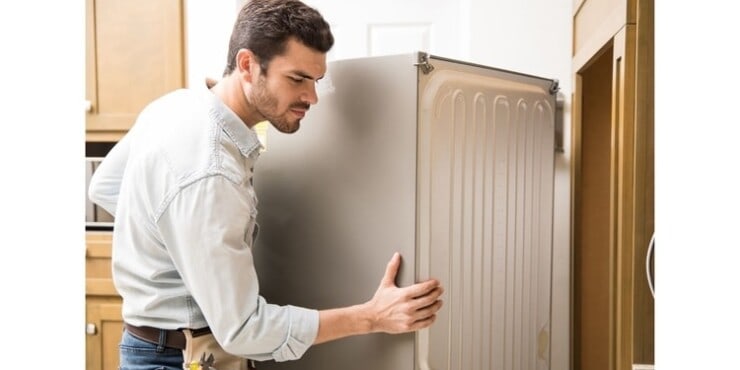We rarely move refrigerators; once they’re set up in the family kitchen, they remain there until the family chooses to relocate to a new home.
But when you do need to move your refrigerator, you should be cautious- after all, no magic formula will make moving a fridge any less painstaking. See, refrigerators are not only bulky, weigh more and cumbersome but expensive, too.
So, when moving, you should be quite attentive to avoid any risks. Now, during the moving process, you might find tipping or even laying it on its back necessary to get through a vehicle, door, or upstairs.
While this is occasionally unavoidable, laying your refrigerator on the back or side is not ideal and can cause problems.
Sure, your instincts will want to lay the refrigerator on its side, but regardless of how “natural” it feels, you must avoid this temptation, because even small shifts may damage it. Failure to keep your refrigerator might cause serious damage to your unit, which we shall look at shortly.
Titling may Shift Fluids
One of the major risks of laying a fridge on its side or back is that it might cause the movement of fluids to the location they aren’t supposed to be.
See, fridges usually contain several fluids such as oil, lubricants, refrigerant, and more. When a fridge is tilted, these fluids might move to locations they should not be at.
For example, the oil inside the compressor may drain and travel to the refrigerator line. And as we know, oil is incompressible, meaning once the fridge is plugged back in, the compressor might automatically lock up.
Disrupting Shelves
Another potential problem caused by laying a refrigerator on its side is the potential of tilting or rather sliding of the shelves.
Depending on your refrigerator model, some of the units are designed with shelves that remain in place because of gravity.
Now, when you tip a fridge, the shelves become dislodged, knocking, and bouncing around inside the unit. This can be an inconvenience if they’re made of plastic, but it can be disastrous if they constructed from glass.
Of course, this is a minor problem compared to the possibility of oil sipping through the refrigerant line.
How To Move a Refrigerator
So, how do you prepare your fridge for transit and reduce the chances of breakage?
1. Empty your Fridge
The first thing when moving your fridge is to empty it, and this isn’t just because about weight purposes but also safety.
2. Remove the Shelves and Drawers
Besides emptying the food, ice cubes, and any food material, you should also remove anything detachable to the fridge or rather any components that could tilt such as drawers, shelve, and dividers.
3. Securing the Doors
The final prepping action is to secure the fridge door with a rope or duct tape. Don’t tie the rope to tight to avoid misaligning the door.
Also, do not keep the refrigerator door completely closed, especially when moving for a long duration, as this might trigger the growth of mold and mildew or collecting of odors. Instead, prop the door open an inch or so with a ball or piece of cardboard.
What To Do If You’ve Moved your Refrigerator on its Side?
As I had earlier mentioned, I cannot altogether avoid tilting your fridge in one way or another; you will be forced to tilt, especially when moving through the tight spots.
Settling
After moving your fridge on its side, you must let it sit in an upright position for the same amount it was on its side before plugging it in.
This will allow any oil that may have flowed into the coolant line to have sufficient time to return to the compressor and clear the coolant lines.
Lines
If you’re forced to turn a fridge on its side for a lengthy period, ensure that it lays on the opposite side from where the compressor lines run out the compressor.
Go through the manual carefully, and this should help you understand the process tube s well as the discharge line.
When turning on its side, turn it, so the discharge line is above compression, and this will prevent oil from running into the discharge line.
For instance, if the compressor line is on the right side of the unit, you should lay the fridge on its left side.
Conclusion
The best thing to do is not to let the fridge lay on its side at all.

